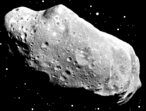Select a family/group from the list and other filters. The search returns short ephemerides for the asteroids found in the search.
The Family definitions are based on Nesvorny et al. (2015) along with an additional 60 families defined on the AstDys site. For those objects not in those lists, the group assignment is based on osculating a, e, i orbital elements as outlined in "The Asteroid Lightcurve Database" by Warner et al. (2009).
The last assignments are meant only as a guide since there are families and/or groups that share the broad orbital space defined by the orbital elements.
Enter Longitude and Latitude to the nearest whole degree (Western/Southern Hemisphere = negative)
For example: Landers, CA = –105 +39; Adelaide, Australia = +138 –34)
Enter Elevation above sea level, in meters (1 foot = 0.3048m)
Enter UT (nearest whole hour) for the position on each date. Do not use
a leading zero for values < 10.
The Mag Range values set the brightest (Low) and dimmest (High) magnitudes for the initial and final search. For searches with Family Number >= 9000, this is very important since it can elimate bypass the hundreds to thousands of objects that are brighter than the Low value.
The Sun and Moon Elongations are the great circle distances (degrees) from the object.
Please note: If looking for objects with an Family Number >= 9000, the search may take awhile, especially if selecting "All" for the family subset. If you get a server timeout error, try doing the search again using a subset of "Numbered" or "Unnumbered" and/or using a dimmer, narrower range for the Mag Range vaules.
The initial search, i.e., when only the subset and limiting magnitude filters are applied, is limited to the first 10,000 records.. That should still provide (too) many potential targets!


